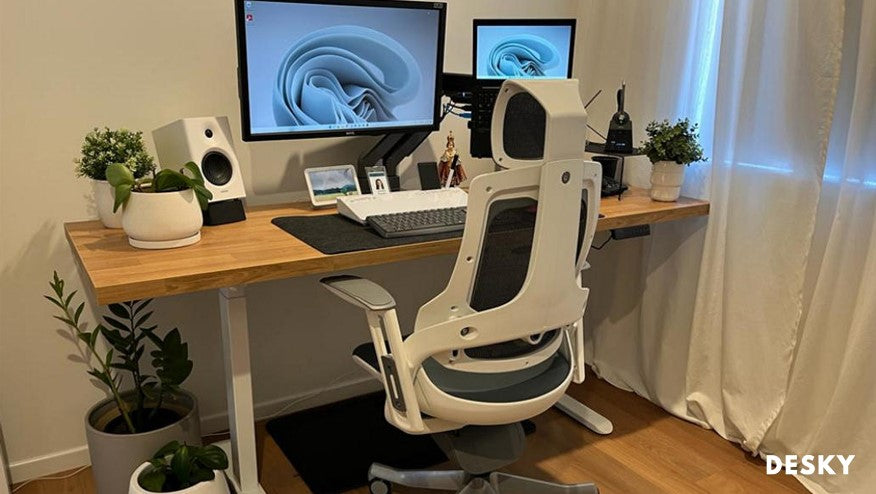
News
How To Fix A Sinking Office Chair: Five Easy Steps
Hayden AdamsA decent office chair is one of the best investments you can make in your workplace. It’s important for your comfort and well-being, and can save you from aches, pains and even RSIs. Finding the correct height for your office chair is one of the most crucial factors in setting the most ergonomic position.
However, even the most expensive office chairs can experience a common problem: sinking. When faced with this frustrating issue of a sinking desk chair, thankfully you don't necessarily have to rush into buying a fancy new mesh office chair. If you need to, you can easily fix it yourself and continue to make the most out of your chair. In this article, we will guide you through two 5 step DIY fixes to stop your office chair from sinking.
Is It Time To Replace Your Sinking Office Chair?

You’ll know better than anyone if your chair needs to be replaced. One of the sure signs normally is when the pneumatics go - but if you’ve made it this far, you may be setting up to persevere a little further. We’re here to help you with that, but it is worth considering before you repair, that even the best bodge job won’t get your beloved office chair working fully - we can only help you find your best height and stay there.
If you want a fully ergonomic and adjustable office chair, now might be the time to start looking at some of the office chairs Desky has on offer.
Investigating the Chair's Consistent Sinking
To understand why your chair keeps sinking every time you take a seat, you need to comprehend the basics of chair mechanics. Ergonomic chairs typically contain pneumatic systems, essentially chambers filled with air that allow the seat to go up and down. But if your chair can't hold its position, it's likely due to a worn-out or defective cylinder.
{{ spec_adj_high_back_mesh }}Why Does Your Office Chair Sink?
‘Sinking’ in office chairs is often caused by a worn or broken seal in the pneumatic cylinder, which controls the chair's height using pressure. When the seal fails, it can no longer regulate in pressure, resulting in the chair continuously sinking.
This is obviously problematic, as it prevents you from maintaining the optimum position to work. This could result in neck strain, back ache, lower back pain, and even repetitive strain injury, it's also just plain annoying. It could be a sign you need to replace your office chair - but before you do, it might be worth trying one of our DIY methods to see if you can solve the problem yourself.
Hydraulic Chairs
Hydraulic chairs, also known as hydraulic lift chairs, are seating solutions designed with a hydraulic mechanism that allows for easy height adjustment. This mechanism uses fluid dynamics to provide smooth and precise movements, enabling users to raise or lower the seat to their desired level effortlessly.
By pulling up or pushing down on these levers, you can adjust the height of the chair to your preference. It's also vital to check the chair's tension knobs, which can be tightened or loosened as needed for the perfect fit.
Fixing Hydraulic Chairs
Is repairing the hydraulics an option for your office chair? It's indeed possible, but it's worth noting that problems with the cylinder could be expensive to rectify. Most office chairs' cylinders fail within a few years, primarily because the seals become too damaged to hold pressure.
Repair Solutions for a Drooping Chair
Consistent plummeting in your chair can be infuriating. Fortuitously, there are ways to resolve this issue. Below are key strategies for fixing a chair that continually sinks:
- Check the Adjustment Mechanism: If your chair's height lever isn't responding, it could mean there's a problem with the mechanism itself. You might need to replace or fix this part of the chair, but before that, use a bit of lubricant like WD40 to see if it can get things moving again.
- Replace the gas cylinder: If the seat sinking persists, replacing the defective gas cylinder, also known as a chair lift, might be necessary.
- Use a hose clamp: As a temporary solution, a hose clamp can restrict the chair's vertical mobility, preventing the chair from sinking.
Fixing the Sinking Problem: Two Methods
Method One: The PVC Pipe Technique for fixing a sinking office chair

Step 1: Measure the Cylinder
Locate the metal cylinder, which is usually covered by a plastic tube, or something similar. Measure its length when the chair is at your ideal height. Measure (or estimate) the cylinder or plastic tube's diameter as well.
Step 2: Cut PVC Pipe To Length
Find a PVC pipe that is slightly wider than the cylinder's diameter and cut it to the appropriate length using a standard saw.
Step 3: Open the Pipe
Using a saw, cut the PVC pipe lengthwise on one side.
Step 4: Attach the Pipe to the Cylinder
Now, you need to apply the pipe where you have just cut: it should pop onto the tube so it fits snugly around the metal cylinder. If it's difficult to fit, you can cut the pipe into two smaller sections to decrease the resistance. Cutting the pipe into smaller sections can be a good idea anyway, as it may allow you to make adjustments to the chairs height to find the best position.
Step 5: Check and Adjust the Height
Sit back down on your favorite office chair and ensure the height is suitable for you. You can increase the height by adding more pipe or decrease it by removing some. As I pointed out above, if you have already cut the pipe into smaller sections this may be easier (though taking correct measurements in the first instance will save you a lot of hassle - measure twice, cut once as they say!).
Raising an Office Chair Manually
If your chair refuses to cooperate, here's one way to manually rectify it: You can insert a pipe clamp into the gas cylinder. Tighten this to the desired chair height. Although it lacks the convenience of adjustable height, it still secures your chair in a preferred fixed position. Below is a more detailed step-by-step guide on how to do this.
Method Two: Using a Hose Clamp and Duct Tape

Step 1: Expose the Cylinder
Uncover the metal cylinder as already explained in Method One. Slide the tube aside or remove it completely, but remember to re-attach the wheels before proceeding.
Step 2: Set and Clamp the Height
Set the chair's height to your preferred height and desired level, as it can't be adjusted later in the process. Ideally, the chair upside height should align with your knees when standing. Imagine you are sitting on the chair and line it up with your desk and monitor if possible. As close as possible try to find the optimum position. Once set, nip down to the hardware store and pick up a hose clamp. Use that hose clamp to hold the seat in place without fully tightening it.
Step 3: Apply Duct Tape
Wrap duct tape around the area where the hose clamp will grip. This creates a better surface for the clamp to hold onto. Alternatively, you can key the metal surface using heavy-duty sandpaper.
This will help to increase the tape’s hold on the metal cylinder by increasing the surface area and therefore the grip. Either way, you need to ensure the surface is clean and free of grease or oil.
Step 4: Test the hose Clamp
Tighten the clamp until it’s as tight as seems safe, and check if it holds the seat in place. If it still slides, try tightening the clamp more. If this doesn’t work, you can try roughening the surface further - if you didn’t key it before, now would be the time to get the sandpaper out and get working on it.
Step 5: Test your desk Chair
With a properly tightened clamp, your desk chair should no longer sink below the set height. Although you won't be able to adjust the chair's height using the lever or mechanism anymore, you can work at least work comfortably without a sinking office chair ruining your flow!
Should You Replace the Cylinder In Your Office Chair Instead?

It is possible to fit a replacement cylinder, and in some cases this will be preferable. Though you may be able to hold your chair in the perfect position with the techniques above, it’s not much use if you need to adjust your height for any reason - and replacing the cylinder would restore your office chair to full functionality.
When you put it like that, it does seem like a pretty convincing idea. However, depending on the chair in question, you may find it hard to find a suitable replacement part - especially one that’s cost effective.
And besides, if you’re not practical, you will probably need to visit a specialist repair shop to have the part fitted. If you want to return to full functionality, you might find that you’re better off replacing the chair - especially if your chair is showing other effects of age, wear and tear.
The Desky Ace is affordable, built to last, comes with a full range of adjustable features - and a 10-year limited warranty. So if you're in the market for a new office chair, perhaps you can start there!
Pros and Cons of Fixing Instead of Replacing Your Chair
Now that you know how to fix a sinking office chair, let's weigh the pros and cons of choosing to fix it rather than investing in a new chair.
Pros
- Cost-effective: Repairing your chair is always going to be cheaper than buying a new one or replacing a major part.
- Speed of Repair: These DIY fixes can be implemented immediately, so you can keep working with no break in play.
- Suitable for short-term use: if you are going to be replacing your chair, these fixes are a great way of carrying you through until the delivery date!
- Super Easy To Pull Off: You definitely don’t need to be a dab hand at DIY to hose clamp a chair, so even the least technical can keep their chair operational in the short term.
Cons
- Aesthetics: Let’s face it, a clamp isn’t the prettiest solution - it might be fine at home, but in a client facing office could give the wrong impression altogether.
- It’s only temporary: our DIY methods on how to fix a sinking office chair are probably not a permanent solution, and you may need to repeat the repairs over time.
- Repeat danger: There's a possibility that the sinking issue may resurface, requiring additional fixes, and you may find yourself buying a replacement in the long run anyway.
A sinking office chair can be a frustrating problem, but at least with these easy DIY fixes, you can extend the lifespan of your chair, if only until reinforcements arrive! Whether you choose to use the hose clamp method and duct tape or opt for the PVC pipe method, these solutions offer a practical way to address the issue (for now).
We’ll trust you to consider the pros and cons of fixing, versus replacing and make the best decision for your situation. Remember though: investing in a high-quality ergonomic chair with a robust cylinder and pneumatics could help you avoid that sinking feeling altogether. Whatever you decide, we hope this might help you squeeze a little more life out of your chair before the scrapheap!
Frequently Asked Questions
How do I keep myself from sliding off my chair?
Apart from constantly lowering itself, your chair could be giving you a literal run for your money by making you slide off. Smooth surfaces on your chair, like silk or nylon upholstery, might induce sliding. Inadequately cleaned surfaces and using detergents containing alcohol could also cause sliding due to a worn-out seat. To eliminate the slipping, you can reupholster your chair with a grip-friendly fabric or clean your chair with proper upholstery cleaners.





